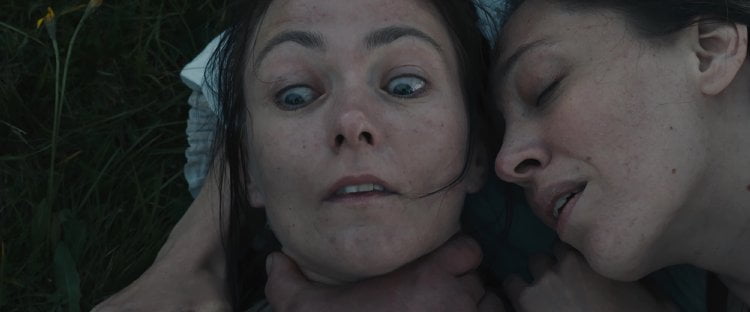Hagazussa: The Heathen’s Curse

Martha (Claudia Martini) trudges home through the snow with her young daughter Albrun (Celina Peter) in hand. She is warned to take care as it is twelfth night and Perchta may be about. That night, three horned figures carrying torches terrorize the two women huddled in their wooden cabin deep in the forest. Later, Albrun will care for her mother, now dying of the black plague. Years later, Albrun (Aleksandra Cwen) has an infant daughter of her own, both scorned as witches in “Hagazussa: The Heathen’s Curse.”
Laura's Review: B+
It is astounding to learn that Austrian writer/director Feigelfeld’s feature debut was his Deutsche Film-und Fernsehakademie Berlin graduation project. This gothic, nightmarish ode to madness, the result of Christian persecution in a 15th century Alpine village, is surreal folk horror that creeps under your skin like the mists which curl up its mountainsides. Feigelfeld’s film will recall Werner Herzog’s “Nosferatu,” Rainer Sarnet’s “November” and Robert Eggers’ “The Witch,” yet his hallucinatory narrative is more ambiguous, his vision darker. The film is divided into four parts, its first, ‘Shadows,’ culminating in the delirious Martha calling Albrun into her bed, smearing her daughter with the young girl’s own recently arrived menstrual blood. Albrun awakens alone, the cabin’s door open. Following her mother’s tracks, she finds her dead in some mud, a snake winding its way around the corpse. ‘Horn’ begins with the bucolic scene of a goat shepherdess. It is the adult Albrun, her infant daughter slung across her chest. But despite the sunshine and wildflowers, Albrun is living much as her mother before her. Walking through the village on her way home, two young boys throw rocks, calling her a witch (hagazussa is Old High German for witch). Swinda (Tanja Petrovskij), a villager around her age, steps in, in apparent friendship, telling her to visit the local priest. The forbidding gothic country church Albrun visits is studded with human skulls and vertebrae, the priest informing her that the community must be cleansed of sacrilege before handing her her mother’s skull, painted with a crown of roses. Albrun is interrupted from her reverie milking one of her goats, a scene director of photography Mariel Baqueiro imbues with an eerie sensuality, by Swinda calling her name. Albrun receives her and her gift of a red apple shyly yet happily, but later, when Swinda speaks of ‘those who don’t carry God’s light in their hearts, the Jews and heathens,’ her duplicitous nature takes an astonishingly dark turn. Traumatized, Albrun’s response involves peeing upon the dead rat she’s thrown into a mountain stream. Are we seeing the effects of her actions in ‘Blood’ or are we experiencing a descent into madness? As the plague spreads, Albrun eats a mushroom, squirming like the maggots embedded in its fungal roots. What she does after wading into an algae coated pond is horrific, ‘Fire’ bringing her further into darkness. Feigelfeld has crafted a cyclical tale embedded with recurring motifs and folklore. The pagan goddess Perchta, for example, was often represented by horned masks, reflected in Albrun’s goats and a hideous barn discovery. Feigelfeld has described fearing witches as a projection of losing one’s mother, a psychology he applies to Albrun. He uses little dialogue, the calling of Albrun’s name significant three times within the film. Baqueiro’s stunning cinematography uses light and shadow to ominous effect, her pond sequence devolving into a swirling liquid merging of blood and backlit underwater flora. The hushed sound design is jolted by the magnification of breathing and chewing. Original music by Mmmd, a Greek duo using custom made instruments, accentuates dread with a foreboding drone. Grade:

